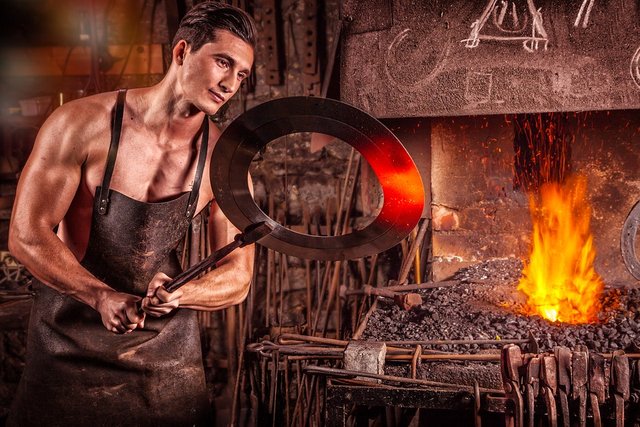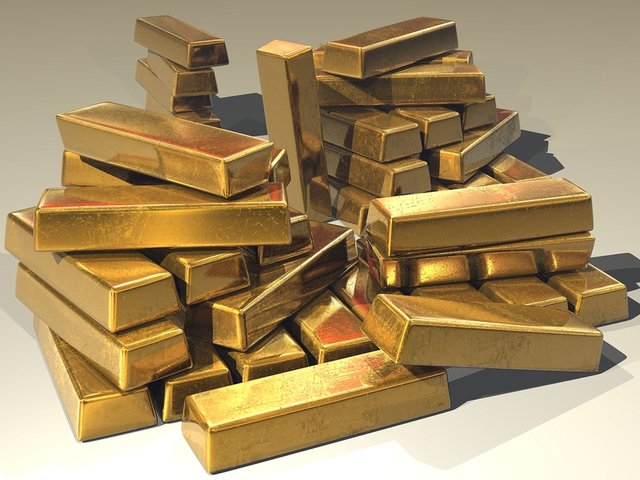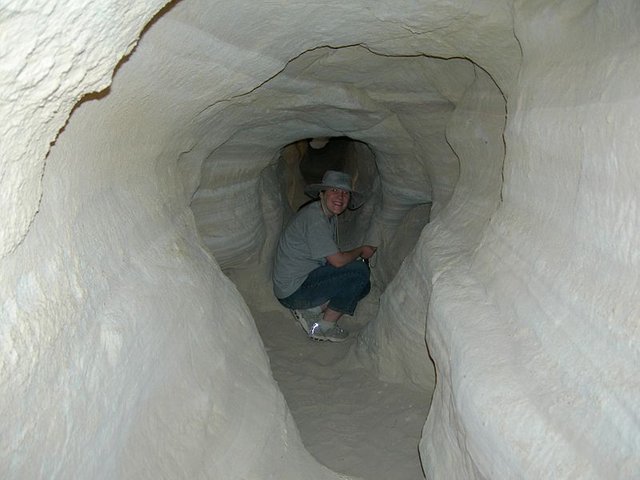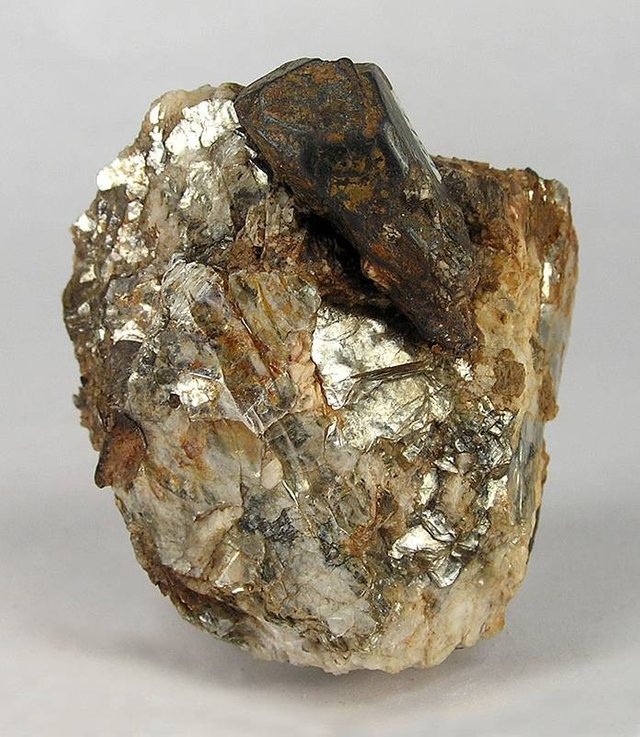Rocks, Metals and Civilization
There was a time in the world of men when structures and tools were built from simple materials; rocks, wood and clay. There was no advance science of synthesizing. Animals bones and teeth were used for their everyday essential life activities. All these happened in the stone age.
Soon, civilization was surfacing. Men began to advance from the use of crude tools into an age known as the bronze age. The bronze age is recorded as starting from 3300 BC. People had access to lumps of copper ore on the ground around this age, and transformed them into tools. Somehow, they discovered the science of smelting copper out of its ore, this lead to the advancement in technology- men began to make alloys of copper, bronze. Bronze was then widely used in making tools and weapons superior to bones of animals. This era is referred to as the Bronze age.

Licence: Public Domain -- Source: Pixabay
Then came the iron age when people began to use the latest metal in town- iron. Iron was far superior to the alloy bronze. Iron has more tensile strength and more solid, this was an advantage applicable to war.
Today, there is now a wide range of materials used in the structures built by men. We have cements, plastics, rubber, cotton and a wide range of metals have been discovered. Not only have we discovered these metal but are able to combine these different metal properties to create a hybrid metal called alloys. Alloys combine the different properties of these metals into one solid metal.
Metals today have varieties of shapes, color, luster and uses. Metals such as silver and gold were used as medium of exchange, copper and aluminum are used in electrical cables, ships and aircraft are built from duralumin, kitchen utensils are made of steel and the list goes endless. Uses of metal is an integral part of human history and civilization. In fact, the use of metal is said to be one of the differentiating factor between man and animals.
The study of metal is known as metallurgy.
Chemistry of Metals
Metals possess certain characteristics distinguishing them from every day materials on earth. These properties which include strength, ductility, thermal conductivity, electrical conductivity, opacity and luster is owed to their unique chemistry.

Valence electron in a zinc crystal, not localized to any atom
Licence: Public Domain -- Source: Wikipedia
There is an attraction force between the electrons of an atom and its proton. This forces keeps the electrons of an atom in place. The energy required to displace or remove the most extremely positioned electron from its atom is known as ionization energy. In the case of metals, this energy is low causing the metal atom to lose its valence electron to form a metallic cation. (e.g Cu 2+).
These electrons lost from the atoms do not bind with atoms of another atom as in case of ionic bonding, instead they shared. These electrons are not associated with or localized to any single atom, hence their label- localized electrons. This is similar to ionic bonding except that the atom donates an electron to another atom which receives it: The first atom in ionic bonding acts as a metal by donating electron(s) to form a cation while the other acts as a non-metal receiving the electron(s) to form an ion as seen in sodium chloride.
These two atoms become ions, one being positively charged and the other negatively charge hence are pulled one to another by an electrostatic force of attraction. Metals don't share their freely moving river of electrons, they are pulled one to another by electrostatic force of interaction.
The attractive force between the metal ions and electrons is very strong, this is responsible for the high melting and boiling point in metals, they are crystalline solid. Metals are able to rapidly conduct electricity and electricity because of the free pool of electrons; Graphite also conduct electricity even though it is a non-metal, this is because it has free electrons like metals.
There are exceptions to these properties; mercury is not solid at room temperature though it because of it less free electrons. Iron is a poor conductor of heat and electricity in comparison with copper. Sodium and lead is are soft metals.
Properties of Metal

Metal have shiny appearance. It a common shared property of all metals
LIcence: CC0 -- Source: Pixabay
Approximately 3/4 of all known element in the periodic table are metals. All elements of the periodic table are grouped into metals, non-metals and metalloids. Non-metals are dull and are no conductor of heat or electricity. Metalloids are hybrid elements possessing the properties of both metals and non-metals. Metals are usually shiny and dense. Metals can accommodate stress, allowing them to form different shapes of objecting without breaking. They possess a high boiling and melting point.
| Metals | Melting Point | Boiling Point |
|---|---|---|
| Platinum | 1770 oC | 3800 oC |
| Gold | 1065 oC | 2710 oC |
| Aluminium | 660 oC | 2450 oC |
| Copper | 1085 oC | 2580 oC |
| Iron | 1540 oC | 2890 oC |
| Nickel | 1455 oC | 2840 oC |
| Silicon | 1410 oC | 2370 oC |
| Silver | 961 oC | 2200 oC |
| Zinc | 420 oC | 980 oC |
Not all metals interact with a magnet, in fact metals are categorized into three based on their interraction with a magnetic field; ferrromagnetic, paramagnetic and diamagnetic metals. Ferromagnetic metals are strongly attracted to magnetic field, this is owing to the configuration of the free pool of electron in the metal crystal. Each electron has a magnetic charge that sometimes cancel each other out, but in case of ferromagnetic metals, they have more un-paired electrons. see more!.
Examples of ferromagnetic metals include iron and alloys of iron, nickel and colbalt.
Paramagnetic metals interact loosely with magnetic fields. While diamagnetic metals are repellent to magnetic fields.
Other major characteristics of metal include having a shiny surface (luster), ductility (ability to stretch under tensile stress), heat conduction and electricity conduction.
Sources of Metal

A miner in copper mining site
Licence: Public Domain -- Source: Wikimedia
A vast majority of metals are found as deposits in ores, only a small faction exists in free states because of their low reactivity, examples include copper, platinum, gold cadnium, aluminium, iron, nickel, lead and silver. Ores are natural aggregation of minerals. These minerals can not be synthesized by cellular or physiological activities: Minerals in this case are metals.
Mining is the economical extraction of ores from their deposits, these could be land or sea. These ores when recovered are refined to extracts its intended minerals. Metal ores are generally oxides, sulfides and silicate of these metals.
Oxides minerals have O2- chemically combined with the metal. This is because the metals are highly reactive. example of oxides ore are columbite [(Fe, Mn)Nb2o6] an ore of iron and manganese, brucite Mg(OH)2. It is often used as an antacid by neutralizing hydrogen irons (H+).Sulfide minerals include sulfur in their equation, the metal is bonded to sulfur. Example include realgar [AsS] containing arsine and sulphur, cobaltite [CoAsS] containing cobalt, arsine and sulfur and pyrite FeS2 containing iron and sulfur.
Silicate are the largest rocks making up 90% of the earth crust. A good example of silicate ore is chrysocolla. It is a germ stone containing hydrated copper and other minerals.
Iron is the 4th most abundant element after oxygen, silicon and aluminium. It is found in ores majorly as hematite- Fe2O3 and Magnitite- Fe3O4. Some are found free in nature uncombined. About 98% of mined iron is used in producing steel which is a more superior metal than iron.
Modern Use of Metal

Musical instruments are also made of metals. Trumpet and Saxophone are made of brass. Electric guitar are made of nickel plated steel
Licence: Public Domain -- Source: Pixabay
There are diverse use of metals today, without them civilization might not have occurred. Boats, railroads, cars and aircraft are often made from duralumin, an alloy of aluminium (95%), copper (4%), manganese (<1%) and magnesium (0.5%).
An alloy is a combination of two or more metals or a metal and another substance. The intention is to combine the strength and individual properties of the involved metals in one. Steel which is an alloy of iron and carbon is much more stronger than iron. It is used in building cars and machinery. Although some commercial iron contain impurities such as carbon, the difference between an alloy and an impure metal lies in the fact that an alloy constituent are intentional, and are monitored to produce desirable results. Chromium is sometimes added to steel to produce stainless steel which is more resistant to rust. Most kitchen utensils are made of stainless steel.
| Alloy | Constituents |
|---|---|
| Monel | Nickel, Copper, Iron |
| Brass | Copper, Zinc |
| Bronze | Copper, Tin |
| Steel | Iron, Carbon |
| Duralumin | Alluminium, Copper, other metals |
| Sterling Silver | Silver, Copper |
Metals are also of clinical importance. Iron is a constituent of the human blood. Many food and blood tonics include some of these metals in physiological quantity and state. They are required for a healthy living.
Some metals are used in electrical conduction and wiring, example include aluminium and copper. Tungsten is a metal found in light bulb. It has the ability to withstand the high temperature needed to produce light rays, it does not melt.
Precious metals are used as jewelries and ornaments, example include gold and silver. Medals are also made from these precious metal. Bronze is an alloy of copper and tin. Diamond is not a metal, it is made of carbon arranged in a particular fashion.
Brass, copper, stainless and aluminium are used for making door handles.
Metals are an important part of our life; religion, music, culture, office, academics, technology and outside-space experience. Although they are not called rocks, I still believe they are rocks, meaning there is just a modernization of the stone age- we never left it.
Thank you!!
Further Reading:
Image declaimer:
All images used in this post are under Public Domain, CC0 and CC-BY-SA-3.0 licencing. Images needing attributions are attributed properly after immediately usage.



Congratulations! This post has been upvoted from the communal account, @minnowsupport, by Damzxyno from the Minnow Support Project. It's a witness project run by aggroed, ausbitbank, teamsteem, theprophet0, someguy123, neoxian, followbtcnews, and netuoso. The goal is to help Steemit grow by supporting Minnows. Please find us at the Peace, Abundance, and Liberty Network (PALnet) Discord Channel. It's a completely public and open space to all members of the Steemit community who voluntarily choose to be there.
If you would like to delegate to the Minnow Support Project you can do so by clicking on the following links: 50SP, 100SP, 250SP, 500SP, 1000SP, 5000SP.
Be sure to leave at least 50SP undelegated on your account.
The metal really helped civilisation to where we are at present.
Hi @damzxyno!
Your post was upvoted by utopian.io in cooperation with steemstem - supporting knowledge, innovation and technological advancement on the Steem Blockchain.
Contribute to Open Source with utopian.io
Learn how to contribute on our website and join the new open source economy.
Want to chat? Join the Utopian Community on Discord https://discord.gg/h52nFrV
Just as I learnt from the Korean epic movie, JUMONG, this post has made us understand how man worked tirelessly in search of better substances compared to what he has presently.
Metals have been used in countless aspects of human existence ranging from buildings, roads, electronics and home appliances. The discovery of metals pave way for many other scientific discoveries.
Thank you for giving us this piece @damzxyno.
I am @teekingtv and I write STEM.
Congratulations @damzxyno! You have completed some achievement on Steemit and have been rewarded with new badge(s) :
Click on the badge to view your Board of Honor.
If you no longer want to receive notifications, reply to this comment with the word
STOPDo not miss the last post from @steemitboard!
Participate in the SteemitBoard World Cup Contest!
Collect World Cup badges and win free SBD
Support the Gold Sponsors of the contest: @good-karma and @lukestokes